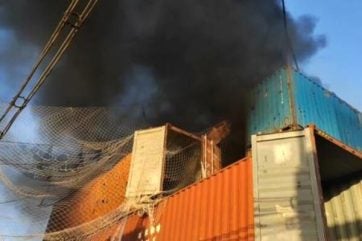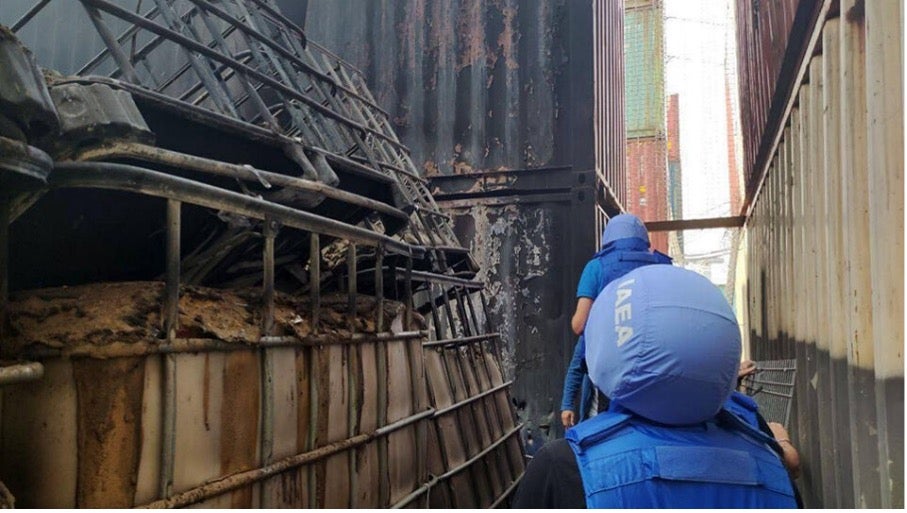
The Raduga transformer substation has been destroyed in Energodar, the Zaporizhia NPP (ZNPP) operators’ town after an artillery attack by the Ukrainian Armed Forces, the ZNPP Telegram channel reported. “A direct hit by the Armed Forces of Ukraine artillery destroyed the transformer of the Raduga substation. There are no casualties,” ZNPP said. It is specified that the supply of electricity to the city is under control. The following day International Atomic Energy Agency (IAEA) inspectors stationed at ZNPP were shown the consequences of the shelling.
“At the moment, no violations of safety limits and conditions have been recorded at Zaporizhia NPP. The radiation background at the station site and in the observation area is normal and does not exceed natural values,” the report said.
In total, there are two substations in Energodar – Luch and Raduga, both of which were previously attacked in Jube and July. Electricity supply to the ZNPP is carried out through the Zarya substation, which was attacked by a drone earlier in September. On that occasion, ZNPP staff had to introduce a backup power supply for plant infrastructure facilities.
The latest update on ZNPP from the IAEA, which was issued before the attack on the Raduga substation, noted that the IAEA team had heard explosions throughout the week, including several blasts close to the site, although no damage to the plant was reported.
The Agency reported on the earlier attack on the Zarya substation noting that ZNPP had informed the IAEA team of an alleged drone strike on the 35/6 kilovolt (kV) substation some 300 metres away from the plant. “This substation provides electricity to non-safety related facilities at the ZNPP, including a grid-water pumping station, a water management plant, and external warehouses. Visiting the affected … the IAEA team observed some impact on one of the substation’s two transformers. Remains of batteries and metal pieces of the alleged drone were also observed in the area. The plant said repairs are still ongoing.”
The IAEA team continued to conduct walkdowns across the ZNPP site, discussing maintenance and other activities important for nuclear safety and security of the plant. However, ZNPP informed the team that it was not allowed to conduct a planned walkdown of the external warehouses and diesel fuel storage facility due to the risk from military activities.
“Ensuring adequate maintenance remains challenging during the conflict. The IAEA team was informed about the five categories of maintenance the ZNPP is implementing to ensure the reliability of the emergency diesel generators (EDGs) and about the scheduling of the maintenance frequency. The ZNPP said category 1 and 2 maintenance, the lowest categories, involving monthly visual inspections and annual maintenance, is ongoing during 2024. More advanced maintenance is planned for some EDGs in the coming years. The team was also informed on the progress of maintenance activities performed on reactor unit 6 during recent months.”

Among other activities, the IAEA team visited the turbine halls of reactor units 3&4 and were again not allowed to access the western parts of the buildings. The IAEA team conducted a walkdown inside the unit 5 reactor building, observing the monthly changeover between cooling pumps of the used fuel pool as well as some of the main reactor components and safety systems rooms.
While Russian officials and media continue to criticise IAEA Director General Rafael Mariano Grossi for failing to identify Ukraine as the source of these attacks, the Russian Permanent Representative to International Organisations in Vienna, Mikhail Ulyanov, noted that there was insufficient evidence. The Agency will be able to obtain evidence of attacks by Ukraine on ZNPP only in the event of a “recklessness” mistake by Kyiv by conducting an attack that can be traced back to them, he told RIA Novosti on the sidelines of Russian Energy Week in Moscow.
“The Ukrainians may be exposed as a result of their reckless actions, but so far, due to the fact that the attacks are carried out by drones that fly automatically along an incomprehensible trajectory, Grossi cannot confirm that the strikes are carried out by Ukrainians,” he said. However, Ulyanov noted that Grossi himself “knows well where the threat to the station comes from”. He stressed that so far there is no evidence of Ukrainian involvement, which Grossi could “weightily and visibly present to the international community”. He added that the presence of the IAEA mission at ZNPP is still justified as it helps to expose Ukrainian and Western lies about what is happening at the station.
Similar comments were made by the Deputy Director General of the IAEA At the same time, the IAEA’s mandate does not allow the organization to take sides and name those responsible for the attacks on the Zaporizhia and Kursk nuclear power plants, IAEA Deputy Head Mikhail Chudakov at the Russian Energy Week. He pointed out that Rafael Grossi is a diplomat, a UN diplomat, a Western diplomat. “And he will never name the culprits if there is no absolute proof.” Chudakov said the explanation of his position “is very simple: as soon as he calls one party guilty, it will stop communicating with him and will expel all representatives from its sites”. He added that it is more important to continue to maintain bridges in order to be able to talk with both sides of the conflict.
Meanwhile, the ZNPP Director Yury Chernichuk told TASS that the restart of the first unit at the plant in the future would be a historic event and would be of interest to nuclear scientists around the world as the station has been shut down for more than two years. He said a lot of people at the plant, even the janitors and drivers, would consider it an honour to witness reconnection of the first unit to the grid. “If additional labour resources are required to launch the plant, there will be enough people willing to help and join the station’s staff.”
However, he added that relaunching even one of the six units would require many complex operations. “If an order is given tomorrow [to switch to generation mode], we will begin these operations with the people we have now. A year and a half ago, we lost water from the Kakhovsky reservoir. It was the main source of water that provided cooling for our equipment. We have a lot of power lines damaged around the station that need to be repaired. This would not be a short process. The equipment that is located at the station would require a detailed survey.”
In another interview with RIA Novosti, Chernichuk discussed the future of the cooling tower that had been damaged by a drone attack in August that had seriously damaged the inside of the facility. He said dismantling the cooling tower and the construction of a new one in its place was possible if the results of further investigation that it could not be repaired.
“If the results of the examination are the most unfavourable, then we are technically, organisationally, motivationally, and financially able to dismantle it and build a completely new facility of this kind in its place or nearby,” he said. There is enough time to conduct an expert examination and the work will not affect the safety of the plant or its potential for generation, he added.
Researched and written by Judith Perera






